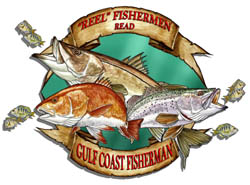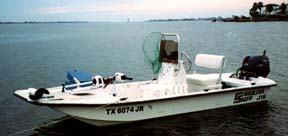
The Saltwater Magazine for Gulf Coast Fishing!
FISHING FORECASTS | FISHING CALENDARS | ARTICLES | SUBSCRIBE
Search Gulf Coast Fisherman's
Web Site
Past articles, specific
places or fish, etc.

New Lake Boat from
MARINE
SERVICE
Port Lavaca, Texas
361-552-4975
OUTFITTING
A Shallow Water Skiffby Berk Elliott
Summer 2005
![]()
| CURRENT
MOON lunar phases |
GULF COAST
FISHERMAN T-Shirts
GCF
T's are here!

Outfitting a Shallow Water Skiff for Under Ten Grand...
There was no warning. The plume of salt spray erupted so violently it was as if someone had dropped a bowling ball into the water. Though the bait was a soft plastic jig, the red drum was feeding so shallow that there was no way to contain the strike beneath the surface. The resulting explosion was dramatic!

The ensuing fight included a couple of laps around the boat and required holding the rod as high as possible to keep the super-charged fish away from the sharp edges covering several small reefs. When the strong 23 inch red was finally led to the net, the small boat was sitting on shell. The light hull was easily extracted with no more inconvenience than a pair of wet feet.
Active bait fish were disturbing the water in the back of the small cove. With the first effort proving so much fun, it was no problem convincing my teenage nephew, Wes Watson, that we should set up another drift through the reefs. Even before we could get into position another boat came cruising into the area. Obviously having seen my bowed rod from a distance, its occupants seemed disappointed upon discovering that their larger boat was drafting too much water to enter the cove.
This was one of the first times I had run my new Carolina Skiff and I was just beginning to realize how shallow this little boat would float. After a morning of chasing working birds out in the bay, Wes spotted the cove and wanted to try it. It was so shallow I honestly didn't think we could get back in there. Just to please him, I kicked the motor up until the prop was barely in the water, eased in and dropped the trolling motor. We were almost on dry sand when the red hit.
After years of running small aluminum boats and catching a lot of fish from them, this boat not only did everything I wanted, but a couple of things I never expected. While every boat is a compromise, this one fits my preferred style of fishing.
It began a couple of years ago when I fell into a small and totally unexpected windfall. After being plagued with a succession of unreliable small motors, I was already saving for a new boat. The extra cash hastened the process and opened the door to more options. Still, I was compelled to maintain a self-imposed budget. Many of the rigs I lusted over carried price tags between $20,000 and $40,000. My target was to stay under $10,000.
While price is obviously a big issue in boat buying, the first consideration has to be matching the rig to your fishing needs. I like to fish around the marsh in the upper Galveston Bay complex, shallow coves in the lower bay and any working birds in between. Though my aluminum boats were getting me there some of the time, I wanted more reliability, more stability, a better ride, better range, etc., while maintaining my shallow water capabilities.
Several events steered me toward considering some kind of skiff. I got my first close-up look at a Carolina Skiff at the Houston Boat Show several years ago. Perkins Marine had a tricked out little J16 model that looked good. I liked their concept which allows the buyer to rig it out to suit them. My only concern was about how that flat bottom hull would ride.
Not long after that introduction, a friend of mine bought a similar Polar Kraft skiff. A couple of fishing trips in his boat eased my concern. It was a pleasant surprise to find just how comfortable and dry it rode. Remarkably stable and easy to handle, I was sold, but I really liked the Carolina Skiff.
When it came time, I wrote a check to Perkins for their J16. The hull is advertised at a petite 330 pounds and it's rated for a maximum 30 horsepower. We decided to mate it with a 25 horse Yamaha four stroke. On good days, she tops in between 25 and 27 mph and, at 20 mph, she will quietly purr all day long on six gallons of fuel. At the ramp, she easily slides up onto her Sportsman trailer.
It was my nature to cut corners on the ouffitting to save money but, in the end, I put together exactly the boat I wanted. My thinking was to assemble it piece by piece over time, but that didn't really happen. Looking to go with the smallest console and a bench seat, I was glad to learn that the more functional medium console and a flip-flop cooler seat didn't cost much more. Better yet, even with rod holders on each side of the console and along the gunnels, there was room to move around.
On a small boat, function is everything. The large bow deck provides storage space, as well as an elevated casting plafform. I had thought to skip a rear deck, but by covering the gas tank, battery, bilge pump, etc., this deck also creates usable space.
As much as I love the fast action provided by fishing under the birds, a trolling motor was a must. Experience had taught me that the bow mount is much more efficient than a transom mount, but there are two problems with this arrangement. The unit bounces too much when you are crossing a choppy bay. We solved this by securing it more snugly with a bungee cord. The other problem involves standing on an elevated plafform on a choppy day. The same pedestal seat you see on a bass boat took care of that. I'm not sitting down while I'm fishing because I'm lazy. I'm just not sure I can swim fast enough to catch my boat if I fall overboard.
Though the console sports the standard array of instruments, I splurged for a depth finder, compass and small GPS unit. While you may want more sophisticated electronics, I opted for a hand held, battery operated GPS with a bracket mount. I'm very happy with its performance.
On one of my first trips out, a heavy pea soup fog settled across the bay and I got to really test my electronics. Following the same track back in that I had made going out, I was elated to find myself passing at exactly the same place between a small island and a crab trap that I remembered from my earlier passage. These things work.
After the break-in period for the little Yamaha, I was totally impressed with my rig, but I had a couple of reservations. While she took me into waters of about the same depth as my old aluminum jobs, she was also grinding the prop in shallow sand and nicking the blades on shell. Also, we were expecting 25 mph at the optimum 5500 to 6000 rpm, but she was turning somewhat better than six grand and still not getting there. This led to the last of my major expenditures.
Bill at Perkins Marine advised against trying to get too much speed out of the rig. At anything over 30 mph, such a light weight boat with a wide, flat bow catches a lot of wind and creates a great deal of lift. It is possible to get airborne.
We installed power tilt and trim, a stainless prop and a hydrofoil. After tweaking the pitch on the prop a couple of times, we got it right. Top end speed increased to better than 25 mph at just under 6000 rpm. The power tilt and trim allows optimum performance from the small motor, while providing a steadying safety valve against that wind-catching bow. As the bow is raised, both rpms and speed increase. When she begins to "porpoise", I lower the bow until she stabilizes.
An unexpected benefit comes from the tilt and trim. By tilting the lower unit until the prop is barely in the water, I can now idle through shallower flats than ever. If I were going to be spending more time in the back lakes around Port O'Connor or Rockport, rather than the deeper waters of the Galveston Bay complex, I would use a jack plate.
For my style of fishing, my electronics, trolling motor and a small drift anchor pretty much cover all the bases. There is a temptation to load a little boat down too much. If I waded more, I would add a small ladder, if not a dive platform. A bimini top is fine for summertime live bait fishing, but they're just in the way for plug casters. For some, a poling platform might be a necessity. Again, you won't see many around Galveston Bay.
A few years ago, I fished down at Rockport with Captain Robert Crumpler aboard a little Hewes Redfisher. It was all tricked out and it sported trim tabs. The maneuvers that rig performed on shell-studded flats were inspiring and watching Crumpler operate that boat was like watching the Maestro play a musical instrument, but the tabs seemed like they'd be overkill on my small skiff.
It should be noted that these small crafts do have limitations. While my rig is packed with enough flotation it isn't supposed to sink, I've no desire to test it. Small skiffs will go offshore, but they don't belong there. You will not find my boat in the middle of the bay during high winds, whitecaps, etc. If you want to ferry half a dozen passengers, you need to look at a bigger Carolina Skiff. With any boat, it's just about common sense
In the end, I did stay within my $10,000 budget. It would have been easy to go over and almost as easy to have remained somewhat below my target. Someone who wades more than I could get by with nothing more than a small console, a bench seat and a portable ladder over the transom. For my fishing style however, my boat is a crucial part of my equipment, almost an extension of my tackle box. I love my Carolina Skiff and I use all the gadgets I have on it.
That day with the red was the day it all came together. As Wes and I
eased into the back of the shallow cove, setting another drift, he sat the
hook almost immediately into what proved to be a 19 inch flounder. Sliding
the net under her, I was thinking, "This is going to be good."

